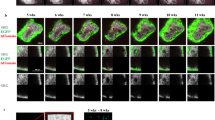Abstract.
We describe a new, highly sensitive semiquantitative method for rapid measurement of in vitro mineralization using calcein. Fluorescence analysis of the calcein bound to the calcium phosphate (hydroxyapatite) allows direct quantitation of extracellular matrix mineral content in monolayer cultures of bone-forming cells such as primary osteoblasts or osteosarcoma cells. Osteosarcoma cell lines UMR 106 and SaOS-2 were used to demonstrate that qualitatively, calcein was bound to the same regions of the mineralized cell monolayer as seen by conventional histological staining with von Kossa or Alizarin Red S. Moreover, total bound calcein could be quantitated by direct fluorescence analysis using a Cytofluor II plate reader. Changes in cell monolayer calcein fluorescence were shown to correlate well with direct colorimetric measurement of acid-solubilized Ca+2 from parallel cultures. Relative mineral quantitation by calcein fluorescence is rapid and more sensitive than colorimetric Ca+2 assays, can be performed directly on unfixed or fixed cell monolayers, and does not require the use of radioisotopes. The cell monolayer remains intact and potentially available for further analysis.
Similar content being viewed by others
Author information
Authors and Affiliations
Additional information
Received: 7 June 1999 / Accepted: 24 January 2000
Rights and permissions
About this article
Cite this article
Hale, L., Ma, Y. & Santerre, R. Semi-Quantitative Fluorescence Analysis of Calcein Binding as a Measurement of In Vitro Mineralization. Calcif Tissue Int 67, 80–84 (2000). https://doi.org/10.1007/s00223001101
Published:
Issue Date:
DOI: https://doi.org/10.1007/s00223001101




